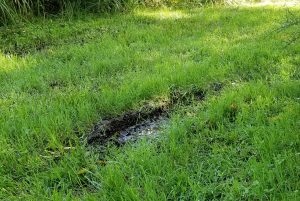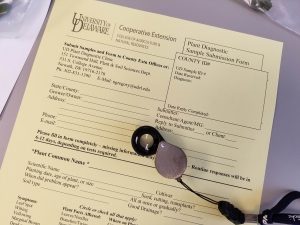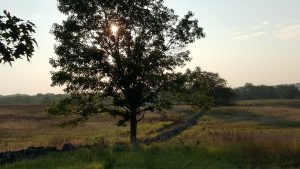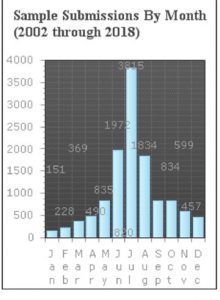Boxwood tips are used in holiday decorations, including wreaths. Carefully inspect wreaths in stores and garden centers before buying. Leaves and twigs may be infected with the boxwood blight fungus, and could be a source of infection for residential boxwood in Delaware. Conditions of wet weather and high humidity have been favorable for boxwood blight in the Mid-Atlantic, where the serious blight has been confirmed. The fungus Calonectria pseudonaviculata causes severe defoliation and death of container boxwoods, and dieback of in-ground plantings. Most boxwood species are susceptible, including American and English boxwood (Buxus sempervirens), little leaf

boxwood (B. microphylla) and hybrids such as B. sinica. Timely and accurate identification by microscopy is important for management of this aggressive disease. If you suspect a wreath or decorative piece is infected with boxwood blight, dispose of it in a bag in the trash, do not compost or discard near foundation plantings of boxwood. Spores would be dormant at this time, but management consists of strict sanitation along with a diligent fungicide schedule over a couple of seasons.
N Gregory Dec 12, 2018
Author: cmanneri
Pest Management in High Tunnels
The Kentucky Pest News, Weekly Newsletter had a great article about pest management in high tunnel situations, mostly biological control, as many chemical control products are not labeled for high tunnel use. Here is the link: https://kentuckypestnews.wordpress.com/2018/11/06/biological-pest-management-in-kentucky-high-tunnel-greenhouse-tomato-production-systems/ .
Addressing mostly arthropod pests, these are good guidelines for disease control too: 
- Sanitation and cultural controls in and around structures, which includes screening and weed control.
- Biweekly Monitoring – visual inspection of plants and sticky cards, keeping written records.
- Recognize pest problems early, before they are at critical levels. Properly identify pests; for some, identifying them to species. County Extension offices can help.
- Release beneficial species (natural enemies and pollinators) – monitor effects – consult with extension specialists. Beneficial species require management.
- Anticipate future problems based on previous crop history (refer to records).
Early Fall Leaf Drop
Excessive rains have led to widespread occurrence of fungal anthracnose and bacterial leaf scorch in trees, as well as other tree diseases, and resulted in lots of mushrooms and bracket fungi. We are noticing many leaves falling early from trees such as silver maple

and sycamore. In disease affected trees, defoliation may be noticeable especially in low lying areas without good air circulation. At this point in the season, leaf spot and drop will have no long term effect on the health of the trees.
NFG 10/5/2018
Boxwood Blight in DE MD PA NJ
Conditions of wet weather and high humidity have been very favorable for boxwood blight in the Mid-Atlantic region, where states have confirmed boxwood with the serious blight. The fungus Calonectria pseudonaviculata causes severe defoliation and death of container boxwoods, and dieback of in-ground plantings. Most boxwood species are susceptible, including American and English boxwood (Buxus sempervirens), little leaf boxwood (B. microphylla) and hybrids such as B. sinica. Pachysandra is a host, and can be a source of spores causing new infections. Sweetbox (Sarcococca) has been identified as a host. Other diseases affect boxwood, and environmental stress plays a role in predisposition to disease.
Most boxwood species are susceptible, including American and English boxwood (Buxus sempervirens), little leaf boxwood (B. microphylla) and hybrids such as B. sinica. Pachysandra is a host, and can be a source of spores causing new infections. Sweetbox (Sarcococca) has been identified as a host. Other diseases affect boxwood, and environmental stress plays a role in predisposition to disease.  Timely and accurate identification by microscopy is important for management of this aggressive disease. Sanitation is extremely important in management. Contact DE Dept of Ag or the UD Plant Diagnostic Clinic if you suspect boxwood blight.
Timely and accurate identification by microscopy is important for management of this aggressive disease. Sanitation is extremely important in management. Contact DE Dept of Ag or the UD Plant Diagnostic Clinic if you suspect boxwood blight.
NFG 9/28/2018
Saturated Soils and Landscapes in Delaware, 2018
WEATHER WOES have plagued us all summer. Monthly data from DEOS (the Delaware Environmental Observation System) indicates that most areas in the state are already over the average yearly rainfall which is 41 inches of rain per year in Delaware. Data from Newark, Dover, and Georgetown show above average rainfall in May of 2018, with 5 to 6 inches in Newark and Dover, but a whopping 10 inches in Georgetown that month. Planting and plant growth was delayed due to cold and wet soils. Temperatures increased in June and July, with rainfall amounts above average. Delaware averaged 47 rainy days out of 100 over the summer months. A dry period occurred in early July, but temperatures were very high during that time. Total rainfall through September 17, 2018 was 40 inches for Newark, 42 inches for Dover, and 43 inches for Georgetown (these values are above our yearly totals!). Storms have resulted in higher rainfall totals slightly to our west. For example, the Fair Hill, MD weather station reported a total of 47 inches of rain to date. With 3 months to go in 2018, soils are very saturated. Saturated soils lead to poor root development and plant health problems,  especially with newly transplanted trees and shrubs. Low lying and wet areas are prone to root rot. Trees in saturated soils with poor root systems may fall over with strong wind gusts. Remove dead or damaged trees near homes and buildings. Repair mower tracks in lawns (photo to the right). Make sure sprinklers are not running on automatic timers if ground is already saturated.
especially with newly transplanted trees and shrubs. Low lying and wet areas are prone to root rot. Trees in saturated soils with poor root systems may fall over with strong wind gusts. Remove dead or damaged trees near homes and buildings. Repair mower tracks in lawns (photo to the right). Make sure sprinklers are not running on automatic timers if ground is already saturated.
NFG 9/18/2018
Is Your Family Ready for a Hurricane or Other Disaster?
[vc_row][vc_column][vc_column_text] With a powerful hurricane coming toward the Eastern United States, and more tropical depressions in the Atlantic, now is a good time to think about weather preparedness. Check weather updates on local news, the National Hurricane Center website https://www.nhc.noaa.gov/, or https://www.udel.edu/udaily/. Make a plan today. Your family may not be together if a disaster strikes, so it is important to know which types of disasters could affect your area; hurricanes, flooding, tornadoes, etc. Know how you’ll contact one another and reconnect if separated. Establish a family meeting place that’s familiar and easy to find.
With a powerful hurricane coming toward the Eastern United States, and more tropical depressions in the Atlantic, now is a good time to think about weather preparedness. Check weather updates on local news, the National Hurricane Center website https://www.nhc.noaa.gov/, or https://www.udel.edu/udaily/. Make a plan today. Your family may not be together if a disaster strikes, so it is important to know which types of disasters could affect your area; hurricanes, flooding, tornadoes, etc. Know how you’ll contact one another and reconnect if separated. Establish a family meeting place that’s familiar and easy to find.
- Put together a plan, know where it is
- Consider specific needs in your household
- Fill out a family emergency plan document
- Practice
For University of Delaware specific information such as closings: https://www.udel.edu/udaily/.
Resources
- Ready.Gov - Plan Ahead for Disasters
- Ready.Gov - Pets and Animals
- PrepareDE.org
- USDA Urges Local Residents to Safeguard Food, Pets, Livestock before Hurricane Florence
- The Extension Disaster Education Network (EDEN) can help, also follow them @EDENtweets.
- More information is available at Delaware Emergency Management: http://www.dema.delaware.gov/ . Follow DEMA on Twitter for frequent updates @DelawareEMA
- WxRisk.com is a private, subscription, Weather Forecasting Company.
[/vc_column_text][/vc_column][/vc_row]
How to Scout and Troubleshoot Crop Problems
New fact sheet/ quick one page guide: take this with you when you scout your fields or  plantings. What you need. What to look for.
plantings. What you need. What to look for.
How-to-Scout-and-Troubleshoot-Crop-Problems-Fact-Sheet-2018
NFG 8/30/2018
Witness Trees – Gettysburg and Beyond
After 155 years, there are still living witnesses to the Battle of Gettysburg and other Civil  War battles, or events in U.S. history: trees. There are over 6,000 acres of land in the Gettysburg National Military Park, and rangers have documented at least a dozen "witness trees" that were alive during the battle. There are also similar trees at Antietam, and at other locations. A recent article by CBS News discusses these old historic trees: https://www.cbsnews.com/news/rooted-in-history-witness-trees-gettysburg-national-military-park/ . Trees that may have been witness trees are very powerful living links that we can view and touch, to events in our history.
War battles, or events in U.S. history: trees. There are over 6,000 acres of land in the Gettysburg National Military Park, and rangers have documented at least a dozen "witness trees" that were alive during the battle. There are also similar trees at Antietam, and at other locations. A recent article by CBS News discusses these old historic trees: https://www.cbsnews.com/news/rooted-in-history-witness-trees-gettysburg-national-military-park/ . Trees that may have been witness trees are very powerful living links that we can view and touch, to events in our history.
NFG 7/20/18
June a Very Busy Month for UD Plant Diagnostic Clinic
June was a very busy month for the UD Plant Diagnostic Clinic, with 160 plant and arthropod samples logged into the data system. Of those samples, 133 or 86% were from Delaware, but 22 were from MD with 5 from VA. Most (87%) were for disease diagnosis, but there were some arthropod ID's, and some plant/weed ID's. Commercial samples through  Cooperative Extension accounted for 56% of samples. Ornamental plants made up 37% of samples, with environmental stress playing a role, and Botrytis and bacterial blight showing up. Vegetable samples made up 40% of the total, and Field Crops 12%. Take all of wheat was diagnosed for the first time in a few years, and anthracnose and gray leaf spot have been seen on corn. Potato and tomato were diagnosed with early blight caused by Alternaria.
Cooperative Extension accounted for 56% of samples. Ornamental plants made up 37% of samples, with environmental stress playing a role, and Botrytis and bacterial blight showing up. Vegetable samples made up 40% of the total, and Field Crops 12%. Take all of wheat was diagnosed for the first time in a few years, and anthracnose and gray leaf spot have been seen on corn. Potato and tomato were diagnosed with early blight caused by Alternaria.
Leaf Spots in Garden Tomatoes
A UD fact sheet, updated in February of 2017 gives timely info on leaf spot diseases of garden tomatoes. Fungal leaf diseases such as Septoria, bacterial leaf spot, and early blight can cause loss of leaves.  Some leaf diseases such as anthracnose can lead to problems on ripening fruit. Click link below for fact sheet:
Some leaf diseases such as anthracnose can lead to problems on ripening fruit. Click link below for fact sheet:
Tomato-Leaf-Spots-Fact-Sheet-Feb2017
